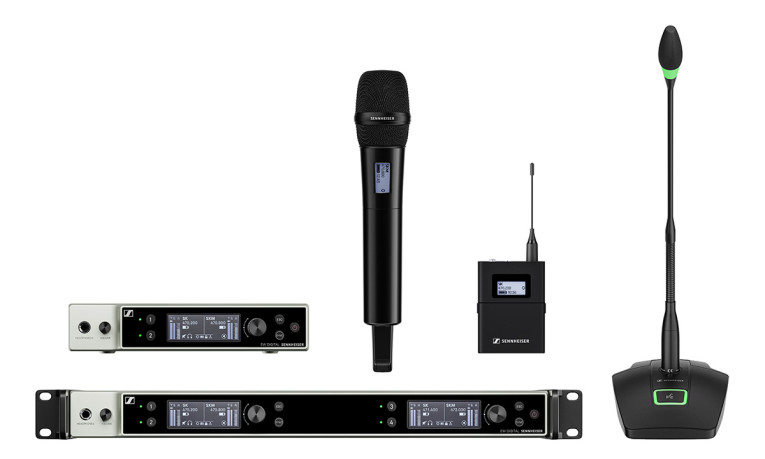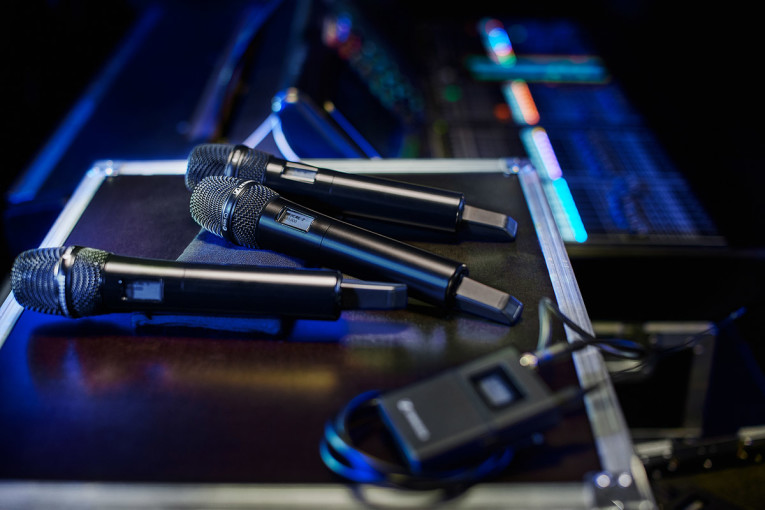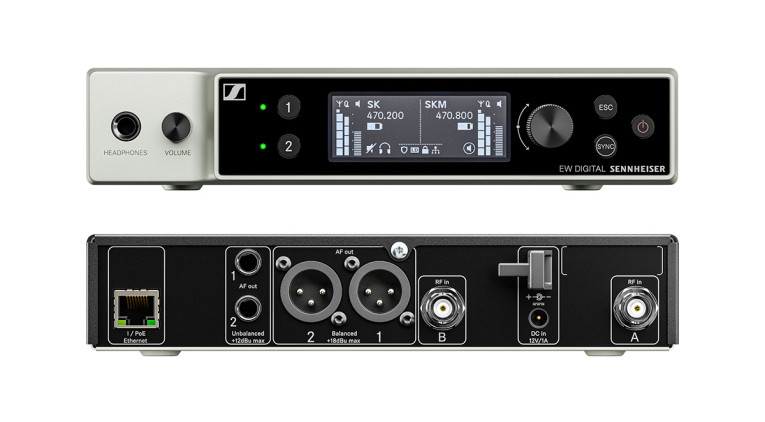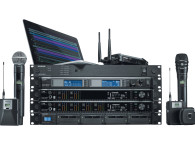
The first products to start shipping include the EW-DX EM 2 two-channel receiver, the handheld transmitter – with or without programmable mute switch – and the bodypack transmitter. The latter also comes in two versions, either with a special 3-pin mic connector or a 3.5 mm (1/8") jack for mics or instrument cables. Convenient set packages are available, too, with further, higher frequency variants ready in Q1 2023, and more EW-DX devices and software being added to the line in mid-2023.
It was originally at InfoComm 2022, that Sennheiser unveiled its plans for expanding the Evolution Wireless Digital family of radio microphones. Named EW-DX, the new microphone systems were designed to simplify professional workflows by utilizing refined technologies and deliver a digital UHF system that can be scaled with ease. The complete set of new EW-DX products includes handheld, bodypack and table stand transmitters, two two-channel receiver versions in a half 19" rack space (one with and one without Dante audio networking) as well as a four-channel Dante-enabled receiver in a full 19" format.
As part of the Evolution Wireless Digital family, the EW-DX series takes the complexities out of wireless and has been carefully engineered to not generate any significant intermodulation products. Therefore, a simple press of a button is all that is needed for the Auto Scan function to automatically assign frequencies using an equidistant tuning grid that allows more channels to be packed into a given frequency window. Transmitters are conveniently sync’ed via Bluetooth Low Energy.

Adding to the single-channel receiver in the family, the Sennheiser EW-DX series offers three receiver versions: a two-channel receiver in a half-rack size, one with and one without Dante; and a four-channel Dante receiver with full 19" rack size. The Dante versions offer various network modes to flexibly integrate into existing workflows. The receivers have a switching bandwidth of up to 88 MHz, which can translate – thanks to Sennheiser’s equidistant spacing – to up to 146 channels in standard mode and up to 293 in link density mode.
The series offers a choice of two bodypacks, two handhelds and two table stand transmitters. Their output power of 10mW ensures a range of up to 100 metres (328 ft). All units benefit from the same wide audio input dynamic range as the existing EW-D models, with the handhelds and bodypacks additionally featuring a trim control to adapt individual transmitters alternating on the same receiver channel, for example when multiple guitars are used.
The handheld and bodypack transmitters are the first on the market to feature e-ink displays. Even when a transmitter is switched off, users will still be able to read all essential device data. Both transmitter types are fitted with in-device charging contacts. Using the dedicated BA rechargeable battery pack, they offer an operating time of about 12 hours.

The bodypack is available with either a 3-pin or a 3.5 mm (1/4") jack microphone connector, enabling it to be used with all digital-proof Sennheiser clip-on and headset mics, Neumann miniature mics as well as instrument cables. The bodypack is fitted with a programmable mute switch and features cable emulation for guitarists and bassists.

The handheld transmitter is also available in two versions, one without and one with an optional, programmable mute switch (RF mute, AF mute, no function). It is fitted with Sennheiser’s standard capsule interface, ready for use with a total of 14 Sennheiser and Neumann microphone heads.
There are also two versions for the table-stand transmitter: A version with XLR-3 connector that takes standard gooseneck microphones; and a version with XLR-5 connector for gooseneck mics with a light ring. The table stands can be recharged inductively with the CHG 2W charging unit, and will run for 11 hours on a single charge.
The Sennheiser EW-DX series is integrated into the Sennheiser Control Cockpit software, Wireless Systems Manager desktop software and Smart Assist App and there also plug-ins for leading third-party control software under development.
"This awesome system combines pro features and ease of use in well-designed, rugged housings. We’re happy to see it hitting the market," says Benny Franke, product manager at Sennheiser. "EW-DX is a more than worthy technological successor to the evolution wireless G4 series and will be setting a new standard in the live audio industry for simplicity, reliability, audio quality and frequency efficiency."

As part of the Evolution Wireless Digital family, the EW-DX series maximizes the valuable resource that is the RF spectrum – and takes the complexities out of wireless at the same time.
Carefully engineered, the systems do not generate any significant intermodulation products. From a spectrum efficiency point of view, this means that the microphones do not pollute the available spectrum with their own intermodulation products, hence more transmission frequencies can be used and distributed evenly at regular distances (the so-called equidistant frequency grid or tuning grid). And frequency calculations are no longer needed.
In standard mode – i.e. with an equidistant frequency spacing of 600 kHz – the EW-DX systems accommodate up to 146 links within its switching bandwidth, and up to 293 frequencies in Link Density Mode (LD, at 300 kHz spacing). This just comes at the expense of approx. 10% of the range. "The Link Density Mode will give users even more room to maneuver in a densely populated RF spectrum," explains Franke. "The slight reduction in range is barely noticed during productions."
Until more charging options become available in 2023, the two-bay, stackable L 70 USB charger will recharge the BA 70 batteries. This charger is also available in the EW-D charging set, complete with NT 5-20 UCW power supply unit and two BA 70 batteries. Meanwhile, the EW-D power distribution cable and matching NT 12-35 CS power supply unit will power up to four EW-DX EM 2 receivers and keep your set-up cleaner. The EW-D ASA active antenna splitter, EW-D AB antenna booster and ADP UHF passive, directional antenna complete the system accessories that are available now.
Sennheiser also announced that in mid-2023, new versions of the Sennheiser Wireless Systems Manager (WSM, for firmware updates and professional operation) and the Smart Assist App (for convenient operation of smaller set-ups) will be available. Following the launch of additional frequency variants and a network-enabled, two-bay, in-device desktop charger in Q1 2023, mid-2023 will see further hardware becoming available, such as two- and four-channel Dante receivers and a dedicated charging module for the L 6000 rack-mount charging unit.
www.sennheiser.com/ew-dx-professional







